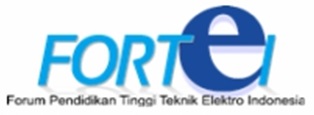Desain Sistem Charger untuk Baterai berkapasitas 650 mAh Menggunakan Sel Surya
Sari
Alat charger untuk baterai berkapasitas 650 mAh menggunakan sel surya merupakan uji coba alat yang digunakan untuk charger baterai berkapasitas 650 mAh menggunakan energi matahari. Baterai 650 mAh ini digunakan pada drone. Alat charger menggunakan sel surya ini digunakan sebagai alternatif pengisian energi pada baterai. Alat ini dirancang dengan menggunakan resistor, kapasitor, dioda, saklar, baterai 650 mAh, LED, sel surya, IC lm317, dan trimpot. Perangkat berupa sistem analog yang menggunakan voltage drop dan memanfaatkan step up & step down serta LED sebagai indikasi pengisian. Hasil uji fungsi dilakukan dengan cara mengukur intensitas cahaya menggunakan alat lux meter, baik pada saat beroperasi maupun tidak untuk mengetahui nilai intensitas cahaya. Masing-masing panel menghasilkan keluaran tegangan rata-rata 6 Volt DC dengan arus 200mA. Untuk memenuhi kekurangan tegangan, keluaran panel surya dimasukan terlebih dahulu ke modul DC-DC Step Up. Dari modul Step Up tersebut dihasilkan tegangan keluaran sebesar 12 VDC yang kemudian dipakai oleh modul charger untuk melakukan pengisian baterai Lithium-ion Polymer (LIPO). Waktu yang efektif untuk proses pengisian baterai menggunakan sel surya adalah pada waktu siang hari sekitar pukul 11.00 sampai pukul 13.00. Dari hasil uji fungsi yang dilakukan, alat bekerja dengan baik yang ditandai dengan LED berwarna merah yang mengindikasikan sedang terjadinya proses charging. Dengan demikian, alat ini bisa dimanfaatkan sebagai pengisian energi alternatif pada drone yang menggunakan LIPO yang memiliki keterbatasan waktu terbang.
The charger for a battery with a capacity of 650 mAh using solar cells is one of tools used for a battery charger with a capacity of 650 mAh using solar energy that commonly used in drones. This solar cell is as an alternative charging energy for the battery. This charger is designed using resistors, capacitors, diodes, switches, 650 mAh battery, LEDs, solar cells, IC LM317, and trimpot. An analog system based on a voltage drop and utilizes step up & step down and LEDs was used as an indication of charging. The testing was carried out by measuring the light intensity using a lux meter, both during operation and not to determine the value of light intensity. Each panel produces an average voltage output of 6volt DC with a current of 200mA. To meet the shortage of voltage, the output of the solar panel is first entered into the DC-DC Step Up module. From the Step Up module, an output voltage of 12 VDC is generated which is then used by the charger module to charge the Lithium-ion Polymer (LIPO) battery. The effective time for the battery charging process using solar cells is during the daytime around 11.00 to 13.00. From the results of the function test carried out, the tool works well which is marked by a red LED which indicates the charging process is occurring. Thus, this tool can be used as alternative energy charging for drones that use LIPO which has limited flight time.
Kata Kunci
Teks Lengkap:
PDFDilihat:
Referensi
R. Harrington, "https://www.businessinsider.com/," 29 September 2015. [Online]. Available: https://www.businessinsider.com/this-is-the-potential-of-solar-power-2015-9?r=US&IR=T#:~:text=In%20a%20single%20hour%2C%20the,with%2018%20zeroes%20after%20it!. [Accessed Friday August 2020].
E. Kabir, P. Kumar, S. Kumar, A. A. Adelodun and K.-H. Kim, "Solar energy: Potential and future prospects," Renewable and Sustainable Energy Reviews, no. 82, pp. 894-900, 2018.
T. Blaschke, M. Biberacher, S. Gadocha and I. Schardinger, "‘Energy landscapes’: Meeting energy demands and human aspirations," Biomasss and Bioenergy, vol. 55, pp. 3-16, 2013.
P. Redweik, "Solar energy potential on roofs and facades in an urban landscape," Solar energy, pp. 332-341, 2013.
H.-M. Henning, T. Erpenbeck, C. Hindenburgh and I. S. Santamaria, "The Potential of Solar Energy use in Dessicant Cooling Cycles," International Journal of Refrigeration, Vol.24, No.3, pp. 220-229, 2001.
S. Fuada, "Helm Charger Tenaga Surya: Kajian Prospek Bisnis Berbasis Technopreneur," Kongres Ilmu Pengetahuan Nasional (KIPNAS) X, Jakarta, 2015.
F. Bishay and M. M. Botros.United States Design Patent US D644,168 S, 2011.
T. Nomi and S. Oda.United States Patent US D657,305S, 2012.
N. Z. Elfani and P. Sasmoko, "Power Bank Portable Solar Charger Menggunakan Sistem Buckboost Converter Berbasis Mikrokontroler ATMEGA 32," Jurnal Gema Teknologi, Vol.18, no.4, pp. 15-20, 2016.
I. Sumirat and R. R. Tugonggo, "Aplikasi Sel Surya Sebagai Energi Alternatif," Jurnal Teknik Elektro dan Sains, 2014.
B. Anto, E. Hamdani and R. Abdullah, "Portable Battery Charger Berbasis Sel Surya," Jurnal Rekayasa Elektrika, Vol. 11, no.1, pp. 19-24, 2014.
M. E. Thompson.United States Patent Patent 4,539,516, 1985.
R. P. Putra, "eprints repository software," 2016. [Online]. Available: http://eprints.polsri.ac.id/3780/3/BAB%20II.pdf. [Accessed 1 August 2020].
D. Suryana and M. M. Ali, "Pengaruh Temperatur / Suhu Terhadap Tegangan," Jurnal Teknologi Proses dan Inovasi Industri, vol. 2, no. 1, pp. 49-52, 2016.
M. T. Afif and I. A. P. Pratwi, "Analisis Perbandingan Baterai Lithium-Ion, Lithium-Polymer" Jurnal Rekayasa Mesin, vol. 6, no. 2, pp. 95-99, 2015.
DOI: https://doi.org/10.15575/telka.v6n2.138-146
Refbacks
- Saat ini tidak ada refbacks.
Jurnal TELKA terindex oleh :







Didukung oleh :


Ciptaan disebarluaskan di bawah Lisensi Creative Commons Atribusi-NonKomersial-BerbagiSerupa 4.0 Internasional.



